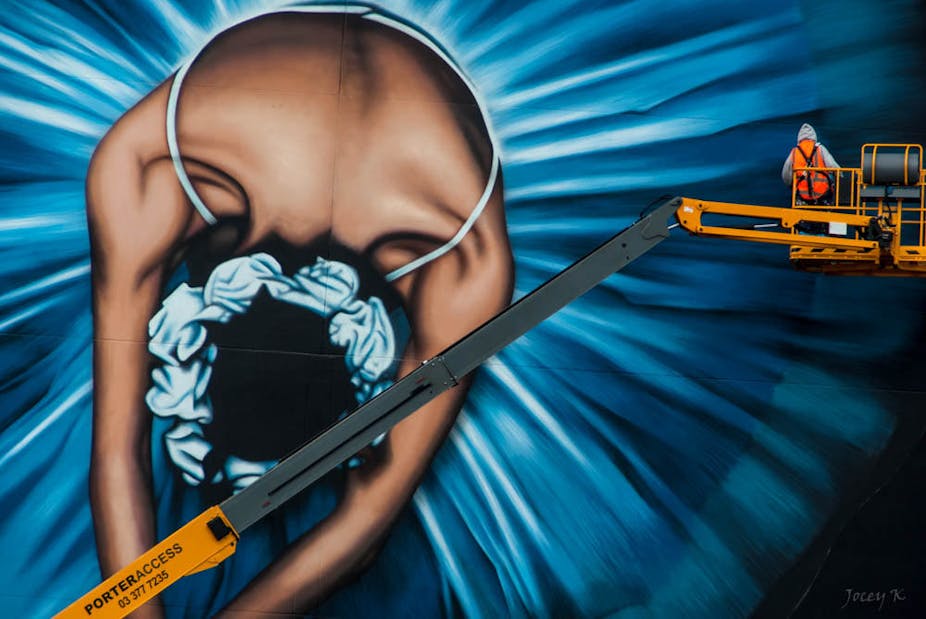Three recent events in the New Zealand city of Christchurch, almost four years on from the magnitude 6.3 earthquake in February 2011, suggest that arts and culture are playing a central role in the recovery of the city’s social fabric.
In the popular memory, Christchurch suffered just two earthquakes. The first on September 4 2010 and the lethal monster of February 22 2011 that killed 185 residents and visitors.
But 2011 was a year of many major aftershocks for Christchurch. One triggered liquefaction under the Christchurch Arts Gallery, requiring a major re-levelling of the building, and another, on December 23, ended the hopes of a relative modest repairs to the Isaac Theatre Royal in the former CBD.
A bull and a piano
One of the early signs of cultural renewal was a bull and a piano. Or more correctly, a massive bronze sculpture of a bull on a piano. It is one of two similar works first exhibited in the New Zealand Pavilion at the 2011 Venice Biennale: On First Looking into Chapman’s Homer by Michael Parekowhai.
Chapman’s Homer stood in the garden of Palazzo Loredan dell'Ambasciatore in Venice, while its companion piece, A Peak in Darien, stood at the french doors at the Grand Canal end of the ground floor ballroom. Between them a pianist played on an intricately-carved Steinway concert grand, painted red for the Venice Republic, while in the garden shrubbery a bronze security guard stood watch.

In the winter of 2012, the director of the Christchurch Art Gallery Jenny Harper, brought the two sculptures to Christchurch and exhibited them just outside the CBD Red Zone barrier. Their bronze-dark formal lines contrasted with the rubble strewn landscape, dotted with derelict buildings, in a chilling and affecting manner.
Within days, the sculptures had been adopted by the citizens of Christchurch as symbols of resistance. By October 2013, NZ$200,000 in public donations had secured Chapman’s Homer for the city. For many it symbolised order and disorder, man and nature, Christchurch and its seismic adversary, and citizens dug deep for this cultural acquisition.
Chapman’s Homer is presently quite at home in New Zealand’s equivalent of Bunnings – PlaceMakers – in suburban Riccarton, its bronze-dark formal lines contrast with the retail clutter of hardware and building materials.
A new audience is found
While donations were accumulating for Chapman’s Homer, the 2013 Christchurch Arts Festival was in progress, a biennial affair.
Deprived of its former city venues, and with only The Court Theatre (the city’s professional theatre company) in its new digs, organisers looked outwards to the suburbs. Suburban high school halls were pressed into service and even that great bastion of rugby, the Christchurch Football Club, opened to the arts hosting Party with the Aunties, a play by director Erina Daniels.

While a study for the Christchurch Arts Audience Development Steering Group in 2013, found that cultural activity since the earthquakes had fallen to 85% (compared with a national average of 95%), something remarkable was happening at the festival. Some 32% of the audiences were first time attendees: one in three had never attended the Christchurch Arts Festival before.
Some contributing factors were easy to identify: performances were focused on weekends, many performances were in residential areas and the ticket prices were low. But this reality remains. Of the over 86,000 festival attendees for ticketed and free events, 27,000 had never previously attended.
Cultural activities were creating new communities in the damaged city. And, perhaps reflecting a shift of audience demographics, the festival’s Facebook following increased by 70%.
The return of the Grand Old Lady
Churches and theatres own special places in the cultural and physical landscape of a city, so the re-opening of Christchurch’s Isaac Theatre Royal last month on November 17, which I attended, was a landmark event.
Some attending had not been to the city centre since September 2010 and, for most, there was a sense of personal ownership and pride in the renewed theatre. That sense of ownership was palpable on the night.
The theatre is owned by the Theatre Royal Foundation, a local not-for-profit that bought the theatre from J.C. Williamson in 1979, its owner of 50 years, in a rundown condition. The Trust gradually returned the theatre to a central place in Christchurch’s community, though theatre manager Neil Cox told me that in recent years, the fabric of the theatre had become tired and no longer offered its once grand theatrical experience to patrons.

The after shocks of 2011 destroyed the auditorium and foyer, but the Gloucester Street facade and the backstage and fly tower were repairable. From the rubble of the building a new modern theatre, behind the old fabric, has emerged.
While government and institutional sources provided much of the NZ$40 million for the rebuild, of no lesser importance have been the efforts of individuals such as Sir Ian McKellen (whose 15 sold-out performances of Shakespeare, Tolkien and You in 2012 raised over NZ$350,000), The Rocky Horror Show creator Richard O’Brien, Sir Peter Jackson, Dame Malvina Major, Hayley Westenra and Christchurch performers Amelia Guild, Emma Newborn and Mel Parsons.
Their work has engaged a whole national community in the recovery of the Isaac Theatre Royal, engendering that sense of shared ownership of a cultural asset.
That engagement binds the local community for the long recovery of the urban material assets that nature has so completely destroyed in central Christchurch.
See also: Three years on: getting creative in post-quake Christchurch

